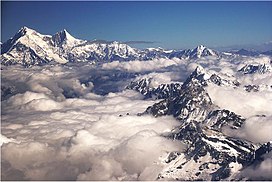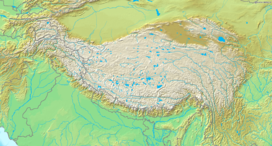| Revision as of 00:50, 27 October 2011 edit虞海 (talk | contribs)Pending changes reviewers5,873 editsm moved Xixapangma to Shishāpāngmā over redirect: oops← Previous edit | Revision as of 00:51, 27 October 2011 edit undo虞海 (talk | contribs)Pending changes reviewers5,873 editsm moved Shishāpāngmā to Xixabangma over redirect: the “common name”, as you claimed, does never include a macronNext edit → |
| (No difference) | |
Revision as of 00:51, 27 October 2011
| Shishapangma | |
|---|---|
| Xixiabangma | |
 Shishapangma (left) from mountain flight, Nepal Shishapangma (left) from mountain flight, Nepal | |
| Highest point | |
| Elevation | 8,013 m (26,289 ft) Ranked 14th |
| Prominence | 2,897 m (9,505 ft) |
| Listing | Eight-thousander Ultra |
| Geography | |
 | |
| Parent range | Jugal/Langtang Himal, Himalayas |
| Climbing | |
| First ascent | 2 May 1964 by Xǔ Jìng et al. (Chinese) |
| Easiest route | snow/ice climb |
Shishāpāngmā (Template:Lang-ne; Tibetan: ཤི་ཤ་སྦང་མ, Wylie: shi sha sbang ma, ZYPY: Xixiabangma; Chinese: 希夏幫馬峰; pinyin: Xīxiàbāngmǎ Fēng), also called Gosainthān (Template:Lang-ne), is the fourteenth-highest mountain in the world and, at 8,013 m (26,289 ft), the lowest of the eight-thousanders. It was the last 8,000 metre peak to be climbed, due to its location entirely within Tibet and the restrictions on visits by foreigners to the region imposed by Tibetan and Chinese authorities.
The Tibetan name means "crest above the grassy plains"., and the Chinese name is a phonetic rendition of the Tibetan name. In Sanskrit, the mountain is called Gosainthan, which means "place of the saint" or "Abode of God". Another interpretation, based on the spelling Shisha-Pangma, is that the name means, literally, "Sherpa Woman."
Geography
Shishapangma is located in south-central Tibet, a few kilometres from the border with Nepal. It is the only eight-thousander entirely within Chinese territory. It is also the highest peak in the Jugal Himal which is contiguous with and often considered part of Langtang Himal. The Jugal/Langtang Himal straddles the Tibet/Nepal border. Since Shishapangma is on the dry north side of the Himalayan crest and further from the lower terrain of Nepal, it has less dramatic vertical relief than most major Himalayan peaks.
First ascent
Shishapangma was first climbed via the northwest face and northeast ridge and face ("Northern Route") on 2 May 1964 by a Chinese expedition led by Xǔ Jìng 许竞. In addition to Xǔ Jìng, the summit team consisted of Zhāng Jùnyán 张俊岩, Wang Fuzhou (Wáng Fùzhōu 王富洲), Wū Zōngyuè 邬宗岳, Chén Sān 陈三, Soinam Dorjê (Suǒnán Duōjí 索南多吉), Chéng Tiānliàng 程天亮, Migmar Zhaxi (Mǐmǎ Zháxī 米马扎西), Dorjê (Duōjí 多吉) and Yún Dēng 云登.
Notable ascents and attempts
- 1980 7 May, "Northern Route", (2nd ascent) by Michl Dacher, Wolfgang Schaffert, Gunter Sturm and Fritz Zintl; Sigi Hupfauer and Manfred Sturm (12 May); as part of a German expedition.
- 1980: 13 October, "Northern Route", (3rd ascent) by Ewald Putz and Egon Obojes, as part of an Austrian expedition.
- 1981: 30 April, "Northern Route", (4th ascent) by Junko Tabei, Rinzing Phinzo and Gyalbu Jiabu, as part of a Japanese women's expedition.
- 1981: 28 May, "Northern Route", (5th ascent) by Reinhold Messner and Friedl Mutschlechner, as part of an Austrian expedition.
- 1982: 28 May, "British Route", southwest face (alpine style), FA by Doug Scott, Alex Macintyre and Roger Baxter-Jones (all UK). Route follows the right-hand couloir on the southwest face.
- 1987: 18 July, Elsa Ávila and Carlos Carsolio become the first Mexicans to summit Shishapangma. For Ávila, her first eight-thousander and for Carsolio, his second, via the northern face/ridge to the central summit, then along the arete to the main summit, with Wanda Rutkiewicz, Ramiro Navarrete, and Ryszard Warecki.
- 1987: 18 September, west ridge, FA by Jerzy Kukuczka and Artur Hajzer (both Poland). Kukuczka skied down from near the summit on this his fourteenth eight-thousander.
- 1987: 19 September, central couloir, north face, FA by Alan Hinkes (UK) and Steve Untch (USA).
- 1989: Central buttress, southwest face, Andrej Stemfelj and Pavle Kozjek.
- 1990: Left-hand couloir, southwest face, Wojciech Kurtyka (Poland), Erhard Loretan (Switzerland) and Jean Troillet (Switzerland)
- 1993: Far-right couloir, southwest face, solo by Krzysztof Wielicki (Poland).
- 2002: 5 May, "Korean Route" on southwest face, Park Jun Hun and Kang Yeon Ryoung (both South Korea).
- 2004: 11 December, Jean-Christophe Lafaille (France) provokes controversy when he climbs the "British Route" on the southwest face, solo, and claims a winter ascent. Since this was not calendar winter, he changes his claim to an ascent "in winter conditions."
- 2005: 14 January, first (calendar) winter ascent by Piotr Morawski (Poland) and Simone Moro (Italy).
- 2011: 16–17 April, Ueli Steck (Switzerland) solos the southwest face in 10.5 hours, leaving base camp (5,306m) at 10:30 pm on 16 April and returning to base camp 20 hours later.
Approximately 22 people have died climbing Shishapangma, including Alex Lowe and Dave Bridges (both USA) in 1999, and veteran Portuguese climber Bruno Carvalho. Nevertheless, Shishapangma is one of the easier eight-thousanders to climb. The standard route ascends from the north side, and boasts relatively easy access, with vehicle travel possible to base camp at 5,000 m (16,400 ft). Routes on the steeper southwest face are more technically demanding and involve 2,200 metres (7,218 feet) of ascent on a 50-degree slope.
Bibliography
- Venables, Stephen (1996). Himalaya Alpine-Style: The Most Challenging Routes on the Highest Peaks. Seattle, WA, USA: Mountaineers Books. ISBN 0898864569.
{{cite book}}: Unknown parameter|coauthors=ignored (|author=suggested) (help) - Scott, Doug (2000 (reprint edition); original 1984). Shisha Pangma: The Alpine Style First Ascent of the South-West Face. Seattle, WA, USA: The Mountaineers Books. ISBN 0-89886-723-1.
{{cite book}}: Check date values in:|date=(help); Unknown parameter|coauthors=ignored (|author=suggested) (help)
References
- "Shisha Pangma on Peakware". Retrieved 16 March 2010.
- Baume, Louis (1979). Sivalaya: explorations of the 8000-metre peaks of the Himalaya. Seattle WA, USA: The Mountaineers. pp. 131–132. ISBN 0-916890-71-6.
{{cite book}}: Cite has empty unknown parameter:|coauthors=(help) - ^ Baume, 1979, op. cit. pp 130-134
- H. Adams Carter (1985). "Classification of the Himalaya" (PDF). American Alpine Journal. 27 (59). American Alpine Club: 122–3. Retrieved May 1, 2011.
- ^ Scott, Doug (2000 (reprint edition); original 1984). Shisha Pangma: The Alpine Style First Ascent of the South-West Face. Seattle, WA, USA: The Mountaineers Books. ISBN 0-89886-723-1.
{{cite book}}: Check date values in:|date=(help); Unknown parameter|coauthors=ignored (|author=suggested) (help) - ^ Scott & Macintyre 2000, op. cit., pp 303-306
- ^ "Korean Highway Corporation 2002 Shishapangma Expedition", k2news.com, 17 May 2002
- ^ " Korean Alpinists Climb New Route on SW Face of Shishapangma", everestnews.com.
- Alpinist Magazine Lafaille article
- "Steck Solos Shishapangma in 10.5 Hours", climbing.com, 18 April 2011.
- "News Flash: Ueli Solos Shisha Pangma in 10.5 Hours", himalayaspeed.com, 19 April 2011.
External links
| Eight-thousanders (and major subsidiary peaks over 8,000m) | |
|---|---|